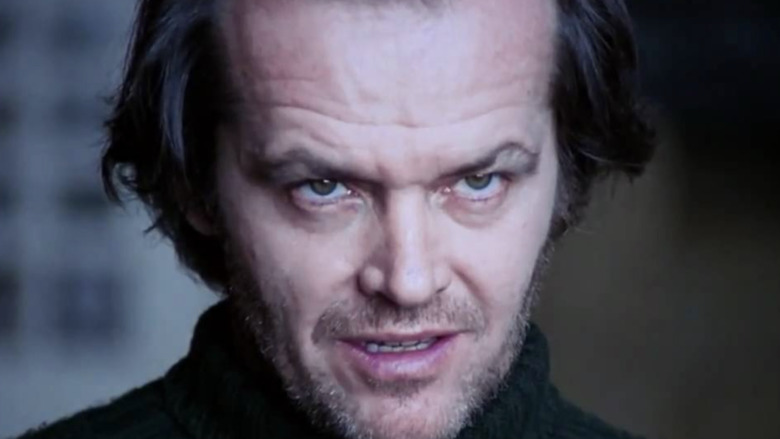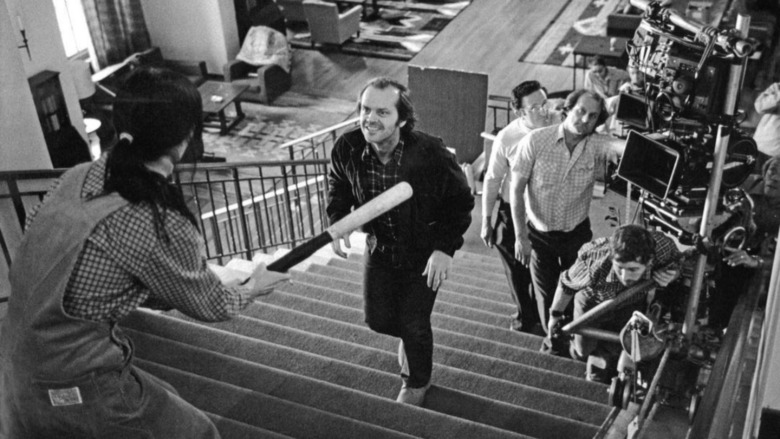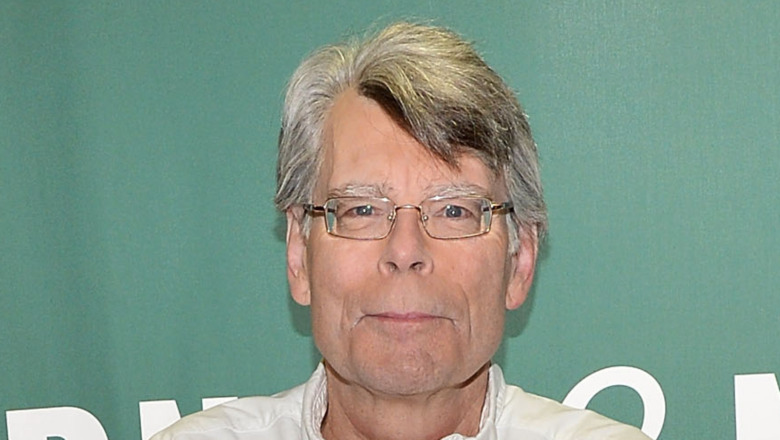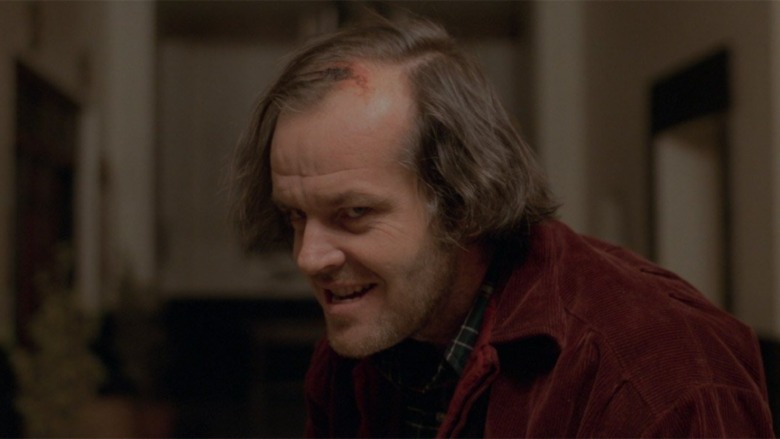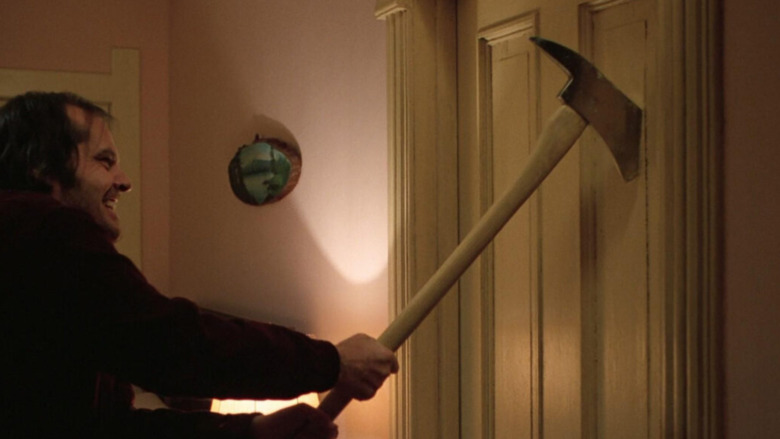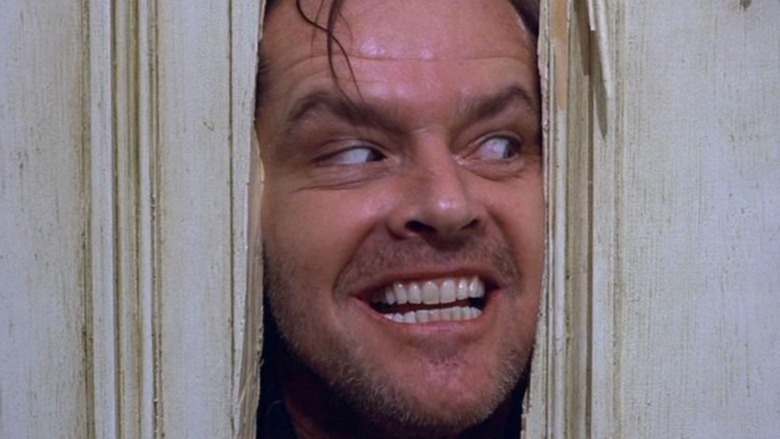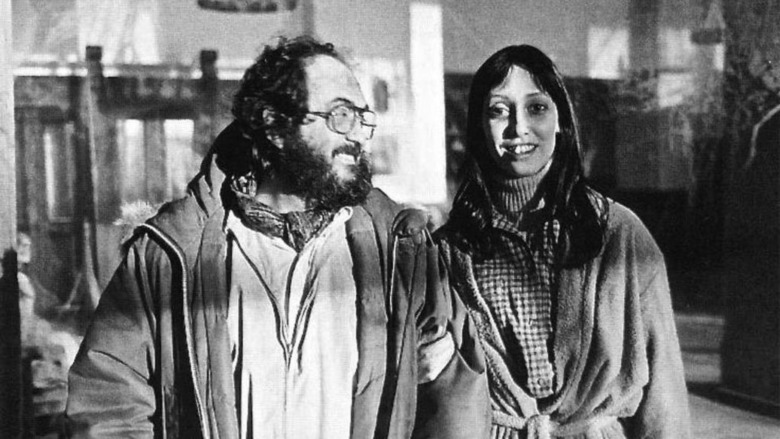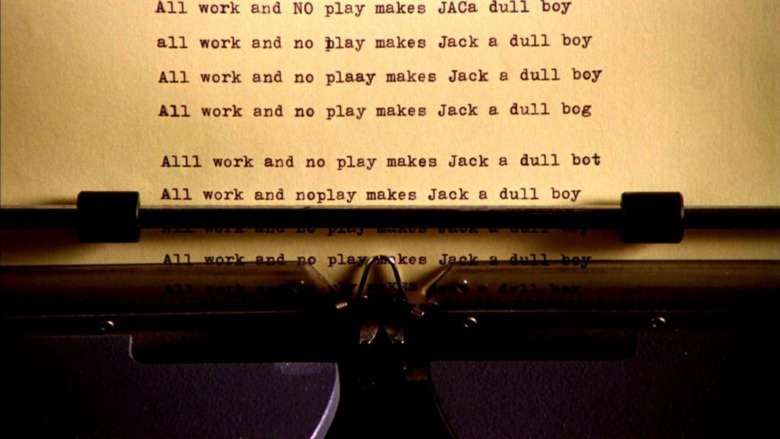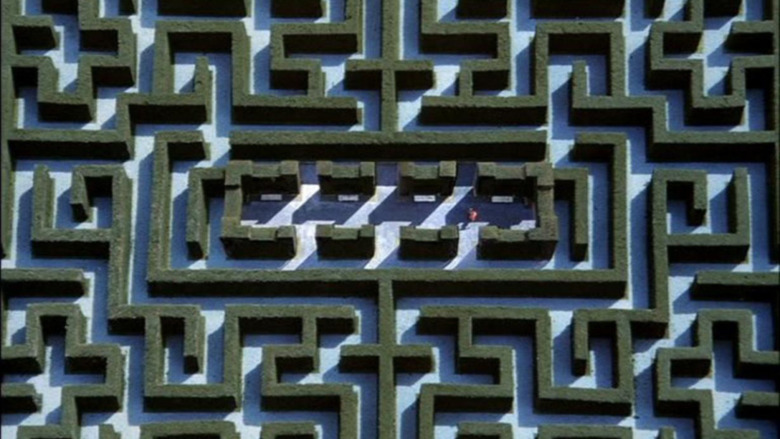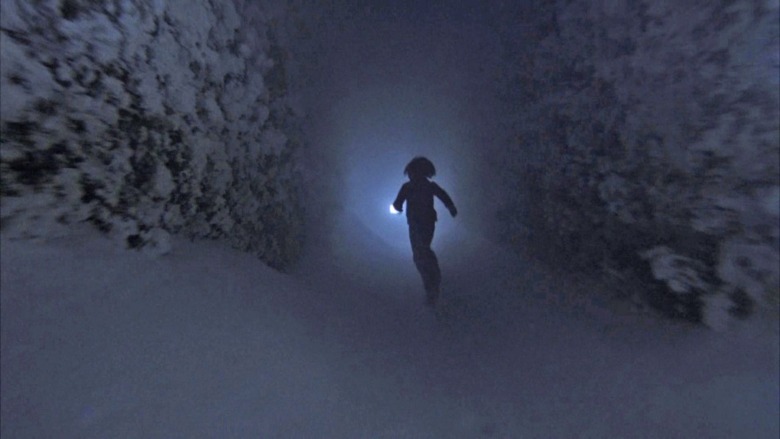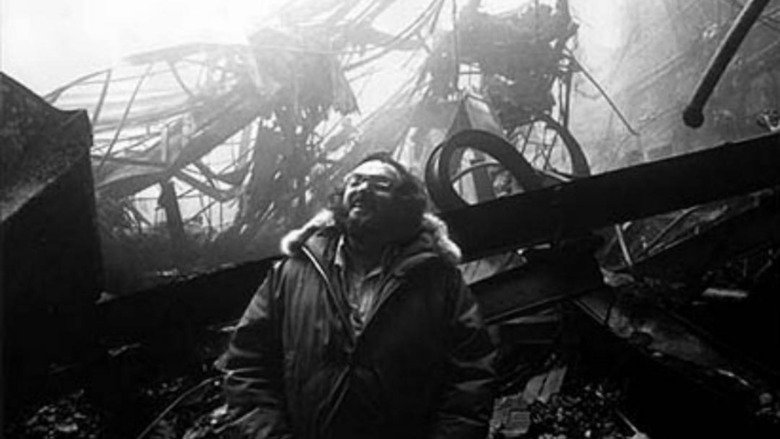Bizarre Things That Happened On The Set Of The Shining
Stanley Kubrick's 1980 horror film "The Shining" is considered one of the greatest horror movies ever made — and for many, you can remove the word "horror" from that title.
Based on the best-selling novel by Stephen King, the flick sees aspiring writer and recovering alcoholic Jack Torrance (Jack Nicholson) take his wife Wendy (Shelley Duvall) and son Danny (Danny Lloyd) to Colorado's secluded Overlook Hotel for the winter to work as an off-season caretaker and hopefully write his novel; as the days go by and the weather becomes worse, however, Danny begins to see vivid apparitions of the hotel's horrific past and Jack begins to lose his sanity, putting his family in danger.
While critics were initially lukewarm towards "The Shining," it has grown to become a staple in the horror genre and has generated constant discussion about its many hidden themes and messages. These hidden meanings include allusions to Native American genocide and if the ghosts are actually present. Kubrick never spoke about the ideas before he died (in fact, he rarely elaborated on any of his films), so the discussions will continue onward alongside the film itself.
The movie is appropriately off-the-wall, and its filming was almost as bizarre. What was slated to be a simple production became crazier and crazier due to perfectionism, non-ideal shooting conditions, and even cheese sandwiches. But do they answer questions about the film itself? Here are ten bizarre things that happened on the set of "The Shining."
17-week shoot turned into almost a year
Production on "The Shining" was supposed to last seventeen weeks, but ended up running almost a year due to Stanley Kubrick's notoriously perfectionist style.
Two decades before he'd reportedly make Tom Cruise walk through the same door frame 95 times, simple scenes such as walking up stairs or a discussion between two characters about psychic powers were reshot again and again until Kubrick thought they were just right. In fact, the discussion between Danny and the hotel's head chef, Dick Hallorann (Scatman Crothers), about their psychic powers known as "shining" took 148 takes and is a Guinness record holder for most retakes of one scene with dialogue.
Philip Stone, who played the sinister Delbert Grady in the film, discussed Kubrick's controversial filming methods in a 1999 editorial for The Independent. "For 'The Shining,' I spent two weeks on the set in Elstree. My scene with Jack Nicholson lasted about eight minutes. We shot it 50 or 60 times, I should think – always in one take. Then Jack Nicholson, Stanley and I would sit down and look at each take on a video. Jack would say, 'That was pretty good, wasn't it, Stanley?' And Stanley would say, 'Yes it was. Now let's do it again'."
Kubrick had a theological discussion with Stephen King
Stephen King has long been outspoken about his disdain for Kubrick's adaptation of "The Shining," but that doesn't mean they didn't connect over the phone during filming.
"He said to me, Stephen, don't you feel that anybody who tells a ghost story is basically an optimist because that presupposes the idea that we go on, that we go on into another life? And I said, well, yes, I can see that, but what about hell? And there's this long pause on the other end of the line. And then Stanley Kubrick said in this very stiff voice 'I don't believe in hell'," King said in an NPR interview in 2013. "To me, it was the voice of somebody who was denying their own maybe deeply-held belief in something that they were unable to root out. You know what the Catholic Church used to say? Give them to me when they're young and they're ours forever. And there might have been some of that in Stanley Kubrick's voice. So he said I don't believe in hell. And I said no, you choose not to believe in hell. And that was the only time I ever really spoke to him on subjects theological."
Jack Nicholson ate cheese sandwiches to get angry
Jack Nicholson gives a hauntingly brilliant lead performance in "The Shining" and was able to capture the deranged mindset of his character using ... cheese sandwiches?
Even though Nicholson won a Best Lead Actor Oscar for "One Flew Over the Cuckoo's Nest" a few years prior, Kubrick still thought he could push him to be even better. Per Far Out Magazine, Nicholson hated cheese sandwiches, so Kubrick fed that to him for two weeks "To foster the sense of disgust, frustration and rage within the actor." Since Nicholson's Torrance has become pretty much the definitive cinematic portrayal of a man gone mad, it seems like the cheese worked.
"Anything you do as many times as a successful actor, you can't have one set of theories. You know, you can go for years saying, 'I'm gonna get this thing real because they really haven't really seen it real,'" Nicholson explained in the "Making 'The Shining'" documentary. "They just keep seeing one fashion of unreal after the other that passes as real, and, you know, you go mad with realism and then you come up against someone like Stanley who says, 'Yeah, it's real but it's not interesting."
60 doors were destroyed for the axe scene
Anyone who has seen "The Shining" will surely recognize the moment when crazed Jack Torrance puts his face to a bathroom door he smashed through and says, "Here's Johnny," but the actual door smashing has some crazy history behind it.
Keeping with Kubrick's perfectionist attitude, the scene took three days to film and involved sixty broken doors. Initially the director used a fake door, but since Nicholson had once trained as a fire marshal, he chopped through the doors too quickly. The fact that Nicholson smashed a real door in the final cut only adds to the authentic horror of this moment.
Moreover, "Making 'The Shining'" shows the lead actor getting into character as he mumbles random phrases such as "come on" and "axe murderer" while pretending to slam the axe into a bed. The documentary doesn't specify which take is being filmed but if it's a later take, then Nicholson must have channeled his frustration into the scene and made the door smashing look more real as a result.
He also improvised the "Here's Johnny!" line
Additionally, the "Here's Johnny!" line wasn't always in the script. Since the shooting script for "The Shining" kept changing during filming, no one is sure what Jack was originally supposed to say when he peeked through the broken bathroom door. Nicholson stopped reading the scripts that were given to him, because they would change anyway, and since Kubrick tends to film scenes many times over the actor had more leeway to say what he wanted to during this pivotal moment.
As for "Here's Johnny," it was of course a catchphrase that announcer Ed McMahon used to introduce "The Tonight Show Starring Johnny Carson." Even though Kubrick lived in the UK and did not watch the show, he was impressed with the line and kept it in the film despite initially having reservations. That was undoubtedly the right move, considering the American Film Institute (AFI) featured "Here's Johnny!" as #68 in AFI's 100 Years...100 Movie Quotes in 2005.
Shelley Duvall was sick and began losing her hair
It's common knowledge that Kubrick emotionally abused Shelley Duvall on the set of "The Shining," which not only affected her mental health but also her physical health.
One moment from "Making 'The Shining'" sees Duvall lying on the floor in a state of exhaustion. "From May until October, I was really in and out of ill health because the stress of the role was so great and the stress of being away from home just uprooted and moved somewhere else and I had just gotten out of a relationship," Duvall explained to an interviewer. "So for me, it was just tumultuous."
Another moment from the documentary shows Duvall pulling out "hunks of hair" and giving it to Kubrick, who nonchalantly tells her to prepare for the next take in response. Even though Kubrick got a great performance out of Duvall for "The Shining," many people may wonder if the ends justify the means.
Kubrick's secretary typed the "All work" pages
The moment when Wendy finds out what her husband has really been typing while he was supposedly writing his novel is an unsettling classic — it also has some interesting behind-the-scenes history.
In the spring of 2009, artists Adam Broomberg and Oliver Chanarin discovered during research in Kubrick's London archives that the director's secretary, Margaret Warrington, had repeatedly typed variations of "All work and no play makes Jack a dull boy" to fill multiple sheets of paper. But instead of typing the phrase on a few sheets like we saw in the movie, Warrington filled an estimated 500 sheets of paper.
As if that doesn't sound torturous enough, Kubrick realized that the scene would lack impact in foreign languages if explained in subtitles, so he commissioned Warrington to write variations of the phrase on an equal number of pages in four different languages (French, German, Italian, and Spanish) for the film's international releases.
The Italian version reads "Il mattino ha l'oro in bocca," which translates to "The early bird gets the worm." Meanwhile, the German version reads "Was du heute kannst besorgen, das verschiebe nicht auf morgen," which translates to "Don't put off until tomorrow what you can do today." Filling the same phrase on 2,500 sheets of paper is obviously tons of work, so hopefully Warrington was well compensated.
Kubrick got lost in the hedge maze
The hedge maze located outside the Overlook Hotel looks difficult to solve, and much of "The Shining" crew proved it. The maze was first built in the MGM British Studios and then recreated in the England-based Elstree Studios, where the movie was shot, yet it was no less difficult to navigate.
Steadicam inventor Garrett Brown, who served as the steadicam operator for "The Shining," explained in a documentary ("View from the Overlook: Crafting 'The Shining'") the difficulties of moving through the maze. "We could never find out where we were. I mean, we would do the shots. Danny would run, you know, whichever way he felt like and we just had to follow him, and we were always lost," explained Brown. "We always had to shout and have somebody work their way in with a diagram and get us the hell out of there."
Hilariously enough, according to the film's production designer Roy Walker, even Kubrick got lost. "We challenged him. We put him in there one Saturday morning," said Walker. "And he couldn't find his way out." For someone who wanted to make sure everything was perfect, it's ironic that Kubrick got lost in the maze that was built for his movie.
The maze chase involved gas masks
Brown explained in an issue of American Cinematographer (via the archived Stanley Kubrick 1928-1999 website) that the crew suffered through difficult shooting conditions while filming the movie's climactic maze chase.
"Roy Walker's men proceeded to 'snow' it in with two feet of dendritic dairy salt and Styrofoam snow crusted on the pine boughs. The quartz outdoor-type lights were turned on and a dense oil-smoke atmosphere was pumped in for eight hours a day," wrote Walker. "Now the maze became an unpleasant place in which to work. It was hot, corrosive and a difficult spot in which to breathe."
Moreover, this atmosphere became so difficult to breathe in the crew had to wear gas masks. "In the beginning we wore gas masks of various vintages. However, I found that I couldn't get enough air to support the exertion of getting from one end of the maze to the other," said Brown. "We never measured the linear distance from the entrance to the center, but I am sure it was a hell of a long way. This was the only time on the picture that I sometimes had to call a halt to the shooting until I could get enough breath to move again." All that hard work paid off, at least.
The set burned down
By far, the most bizarre thing that happened during the filming of "The Shining" was a massive fire that burned down multiple sets near the end of production. Still photographer Murray Close discussed the fire on the popular "Shining" fan site The Overlook Hotel, run by "Toy Story 3" and "Coco" director Lee Unkrich.
"We had a very big fire ... in one of the sound stages. It was the stage that had the set of the Overlook Hotel with the lounge set where Jack typed and he chased Shelley Duvall around with a baseball bat. It was a huge fire in there one day. Massive fire," explained Close. "We never really discovered what caused that fire, and it burnt down two sound stages and threatened a third at Elstree Studios."
Close also discussed a famous a photo of Kubrick in front of the wreckage. "The next day, I was walking around with [Kubrick] and ... I was photographing the damage for insurance purposes," said Close. "We were just talking. Stanley just laughed. He lets the most fantastic laugh out, and I caught this wonderful moment, 'cause he's so rarely photographed, of him ... laughing ... with this smoldering wreckage behind him ... It was a marvelous, marvelous shot." Meredith Danko of Mental Floss theorized that Kubrick laughed because he found some irony in the mishap ... after all, in King's "Shining" novel, the Overlook Hotel burned down.
